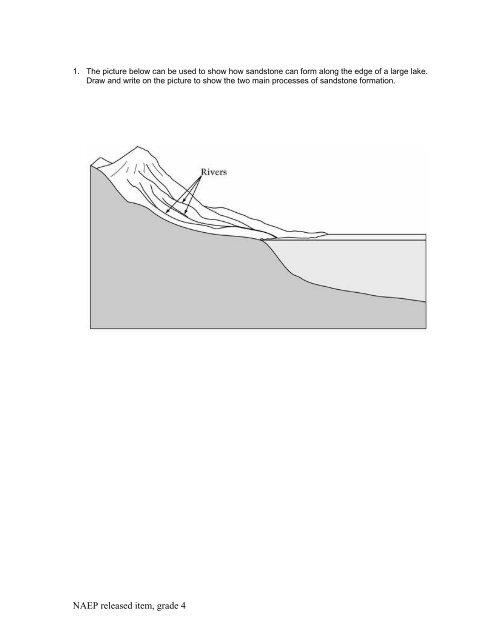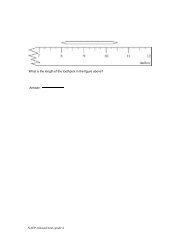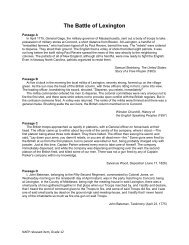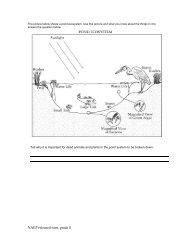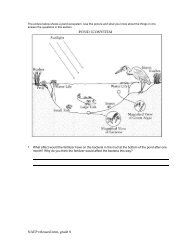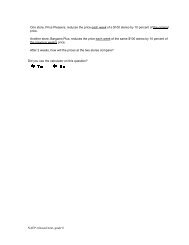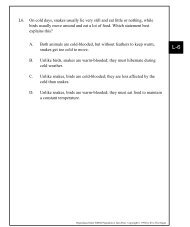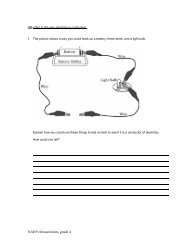Sandstone formation - McREL
Sandstone formation - McREL
Sandstone formation - McREL
Create successful ePaper yourself
Turn your PDF publications into a flip-book with our unique Google optimized e-Paper software.
1. The picture below can be used to show how sandstone can form along the edge of a large lake.<br />
Draw and write on the picture to show the two main processes of sandstone <strong>formation</strong>.<br />
NAEP released item, grade 4
Question 1<br />
Scoring Guide<br />
Score & Description<br />
Complete<br />
Student response includes both parts of the sedimentary process.<br />
• Part 1:<br />
a. Rivers erode mountain material<br />
b. Mountain material is carried by river<br />
c. Erosion<br />
• Part 2:<br />
a. Hardens<br />
b. Solidifies<br />
c. Compacts<br />
d. Builds up in layers<br />
Partial<br />
Student response includes part 1 or part 2 of the sedimentary process.<br />
Unsatisfactory/Incorrect<br />
Student does not demonstrate an understanding of the sedimentary process.<br />
Complete - Student Response<br />
1 The picture below can be used to show how sandstone can form along the edge of a large lake.<br />
Draw and write on the picture to show the two main processes of sandstone <strong>formation</strong>.<br />
NAEP released item, grade 4
Scorer Comments:<br />
Both responses fully describe the sedimentary process. Each response describes the<br />
transportation of sedimentary material by the rivers into the lake and the subsequent compaction of<br />
that material into sandstone.<br />
Partial - Student Response<br />
1 The picture below can be used to show how sandstone can form along the edge of a large lake.<br />
Draw and write on the picture to show the two main processes of sandstone <strong>formation</strong>.<br />
NAEP released item, grade 4
1 The picture below can be used to show how sandstone can form along the edge of a large lake.<br />
Draw and write on the picture to show the two main processes of sandstone <strong>formation</strong>.<br />
Scorer Comments:<br />
Both responses provide a partial description of the sedimentary process. The first response<br />
addresses the transportation of sedimentary materials by the rivers, and the second response<br />
addresses the compaction of that material into sandstone.<br />
Unsatisfactory/Incorrect - Student Response<br />
1 The picture below can be used to show how sandstone can form along the edge of a large lake.<br />
Draw and write on the picture to show the two main processes of sandstone <strong>formation</strong>.<br />
NAEP released item, grade 4
1 The picture below can be used to show how sandstone can form along the edge of a large lake.<br />
Draw and write on the picture to show the two main processes of sandstone <strong>formation</strong>.<br />
Scorer Comments:<br />
Neither response demonstrates understanding of either part of the sedimentary process.<br />
NAEP released item, grade 4
2005 National Performance Results<br />
Score<br />
Percentage of Students<br />
Unsatisfactory/incorrect 69%<br />
Partial 5%<br />
Complete 1%<br />
Omitted 23%<br />
Off task 2%<br />
Note:<br />
• These results are for public and nonpublic school students.<br />
• Percentages may not add to 100 due to rounding.<br />
The Fields of Science: Earth & Space Sciences (Sub content classification: Solid Earth)<br />
Knowing and Doing Science : Conceptual Understanding<br />
NAEP released item, grade 4
The Fields of Science<br />
Earth & Space Sciences<br />
This question measures basic knowledge and understanding of the following:<br />
Solid Earth<br />
• Composition of the Earth;<br />
• Forces that alter the Earth's surface;<br />
• Rocks: their <strong>formation</strong>, characteristics, and uses;<br />
• Soil, its changes and uses;<br />
• Natural resources used by humankind; and<br />
• Forces within the Earth (not in grade 4).<br />
Knowing and Doing Science<br />
Conceptual Understanding<br />
Conceptual understanding includes the body of scientific knowledge that students draw upon when<br />
conducting a scientific investigation or engaging in practical reasoning. Essential scientific concepts<br />
involve a variety of in<strong>formation</strong>, including facts and events the student learns from both science<br />
instruction and experiences with natural environment; and scientific concepts, principles, laws, and<br />
theories that scientists use to explain and predict observations of the natural world.<br />
NAEP released item, grade 4


